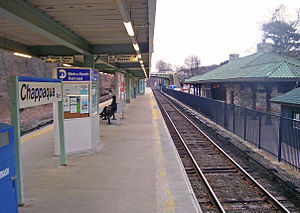Our website is made possible by displaying online advertisements to our visitors.
Please consider supporting us by disabling your ad blocker.
Chappaqua station
Chappaqua | |||||||||||||
|---|---|---|---|---|---|---|---|---|---|---|---|---|---|
 View north from platform, 2009, with historic station on right | |||||||||||||
| General information | |||||||||||||
| Location | 108 Allen Place, Chappaqua, New York | ||||||||||||
| Line(s) | Harlem Line | ||||||||||||
| Platforms | 1 island platform | ||||||||||||
| Tracks | 2 | ||||||||||||
| Connections | Bee-Line: 19 | ||||||||||||
| Construction | |||||||||||||
| Parking | 1,416 spaces | ||||||||||||
| Accessible | Yes | ||||||||||||
| Other information | |||||||||||||
| Fare zone | 5 | ||||||||||||
| History | |||||||||||||
| Opened | June 1, 1847[1][2] | ||||||||||||
| Rebuilt | –June 14, 1902[3] 2007 | ||||||||||||
| Electrified | 1984 700V (DC) third rail | ||||||||||||
| Previous names | Chapequa | ||||||||||||
| Passengers | |||||||||||||
| 2018 | 2,038[4] (Metro-North) | ||||||||||||
| Rank | 30 of 109[4] | ||||||||||||
| Services | |||||||||||||
| |||||||||||||
| Former services | |||||||||||||
| |||||||||||||
Chappaqua Railroad Depot and Depot Plaza | |||||||||||||
| Coordinates | 41°9′28.44″N 73°46′29.64″W / 41.1579000°N 73.7749000°W | ||||||||||||
| Area | 2.7 acres (1 ha) | ||||||||||||
| Built | 1902 | ||||||||||||
| Architect | Nicholas Grant[6] | ||||||||||||
| Architectural style | Richardsonian Romanesque | ||||||||||||
| MPS | Horace Greeley Related Sites TR | ||||||||||||
| NRHP reference No. | 79003210[5] | ||||||||||||
| Added to NRHP | April 19, 1979 | ||||||||||||
| |||||||||||||
Chappaqua station is a commuter rail stop on the Metro-North Railroad's Harlem Line, located in Chappaqua, New York, United States, within the town of New Castle.
Next to the modern station is the building opened by the New York Central Railroad in 1902.[7] Still in use as a waiting area, it is part of the Chappaqua Railroad Depot and Depot Plaza listed on the National Register of Historic Places since 1979.[8] It was built on land donated by the daughter of Horace Greeley, a prominent newspaper editor and presidential candidate who had moved to Chappaqua in the mid-19th century and been responsible for much of its early development, on the condition that a small park adjacent to the station be maintained.[9]
- ^ Dana 1866, p. 216.
- ^ "New York and Harlem Railroad ---- Winter Arrangement". The Evening Post. New York, New York. December 12, 1849. p. 4. Retrieved December 12, 2019 – via Newspapers.com.

- ^ "Chappaqua's Gala Day". The New York Tribune. June 16, 1902. p. 3. Retrieved July 25, 2022 – via Newspapers.com.

- ^ a b METRO-NORTH 2018 WEEKDAY STATION BOARDINGS. Market Analysis/Fare Policy Group:OPERATIONS PLANNING AND ANALYSIS DEPARTMENT:Metro-North Railroad. April 2019. p. 6.
- ^ "National Register Information System". National Register of Historic Places. National Park Service. July 9, 2010.
- ^ "Westchester County Listings". National Register of Historic Places.
- ^ "Chappaqua's Gala Day". New York Daily Tribune. June 16, 1902 – via I Ride the Harlem Line.com.
- ^ "People, Parks & Fire exhibit at the National Association for Interpretation Conference in Virginia Beach, Virginia in November, 2002". National Register of Historic Places. Archived from the original on February 20, 2013.
- ^ Gruber, Walter J.; Gruber, Dorothy W. (August 28, 1977). "National Register of Historic Places nomination, Chappaqua Railroad Depot and Depot Plaza". New York State Office of Parks, Recreation and Historic Preservation. Archived from the original on March 4, 2016. Retrieved April 2, 2013.
Previous Page Next Page



